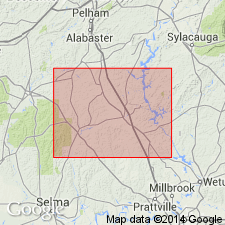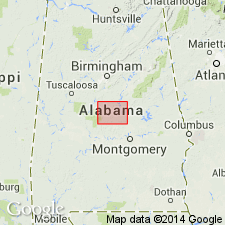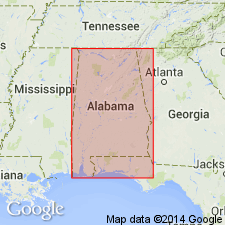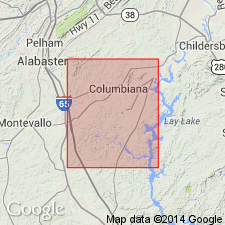
- Usage in publication:
-
- Kalona Quartzite Member
- Modifications:
-
- Named
- Dominant lithology:
-
- Quartzite
- AAPG geologic province:
-
- Piedmont-Blue Ridge province
Summary:
Lay Dam Formation, named in this report, is subdivided into Kalona Quartzite Member and overlying Miller Mill Quartzite Member. Kalona is composed of fine to coarse-grained feldspathic to arkosic quartzite with minor phyllite. Thickness is 182 m. Overlies Jumbo Dolomite. Age is Early Devonian.
Source: GNU records (USGS DDS-6; Reston GNULEX).

- Usage in publication:
-
- Kalona Quartzite Member
- Modifications:
-
- Revised
- Age modified
- AAPG geologic province:
-
- Piedmont-Blue Ridge province
Summary:
Kalona Quartzite Member is here assigned to the Wash Creek Slate of the Kahatchee Mountain Group following recent nomenclature of Tull (1982: GSA Special Paper 191) and other recent reports. Age is given as Paleozoic.
Source: GNU records (USGS DDS-6; Reston GNULEX).

- Usage in publication:
-
- Kalona Quartzite Member
- Modifications:
-
- Overview
- AAPG geologic province:
-
- Piedmont-Blue Ridge province
Summary:
Kalona Quartzite Member of Wash Creek Slate is composed of light-brown to light-gray, fine- to coarse-grained feldspathic quartzite. Wash Creek Slate is uppermost formation of Kahatchee Mountain Group. Age is Late Proterozoic and Cambrian(?).
Source: GNU records (USGS DDS-6; Reston GNULEX).

- Usage in publication:
-
- Kalona Quartzite Member
- Modifications:
-
- Revised
- AAPG geologic province:
-
- Piedmont-Blue Ridge province
Summary:
In the study area, the Wash Creek Slate of the Kahatchee Mountain Group is subdivided into four members: an unnamed ferruginous sandstone member (250 ft above the base of the Wash Creek), the Hillsdale Sandstone Member (new), the Kalona Quartzite Member, and the Mount Zion Church Member (new). In northern Chilton Co., the Kalona forms a discontinuous belt across the southern part of the study area. In the Columbiana area, the Kalona forms the high ridges of the Columbiana Mountain and is present in a klippe of the Kahatchee Mountain thrust sheet overlying the Conasauga Formation. Thickness in this area is 1,099 ft. Composed of white to light-gray medium- to coarse-grained sandstone, which varies in composition from quartz arenite to arkose. Four distinct sandstone horizons are mappable in the member along Columbiana Mountain, each consisting of a sequence of medium to massive trough cross-bedded medium-grained to conglomeratic feldspathic sandstone overlying black shale and siltstone. Age of the Wash Creek and its members is Early Cambrian(?).
Source: GNU records (USGS DDS-6; Reston GNULEX).
For more information, please contact Nancy Stamm, Geologic Names Committee Secretary.
Asterisk (*) indicates published by U.S. Geological Survey authors.
"No current usage" (†) implies that a name has been abandoned or has fallen into disuse. Former usage and, if known, replacement name given in parentheses ( ).
Slash (/) indicates name conflicts with nomenclatural guidelines (CSN, 1933; ACSN, 1961, 1970; NACSN, 1983, 2005, 2021). May be explained within brackets ([ ]).

